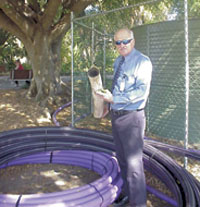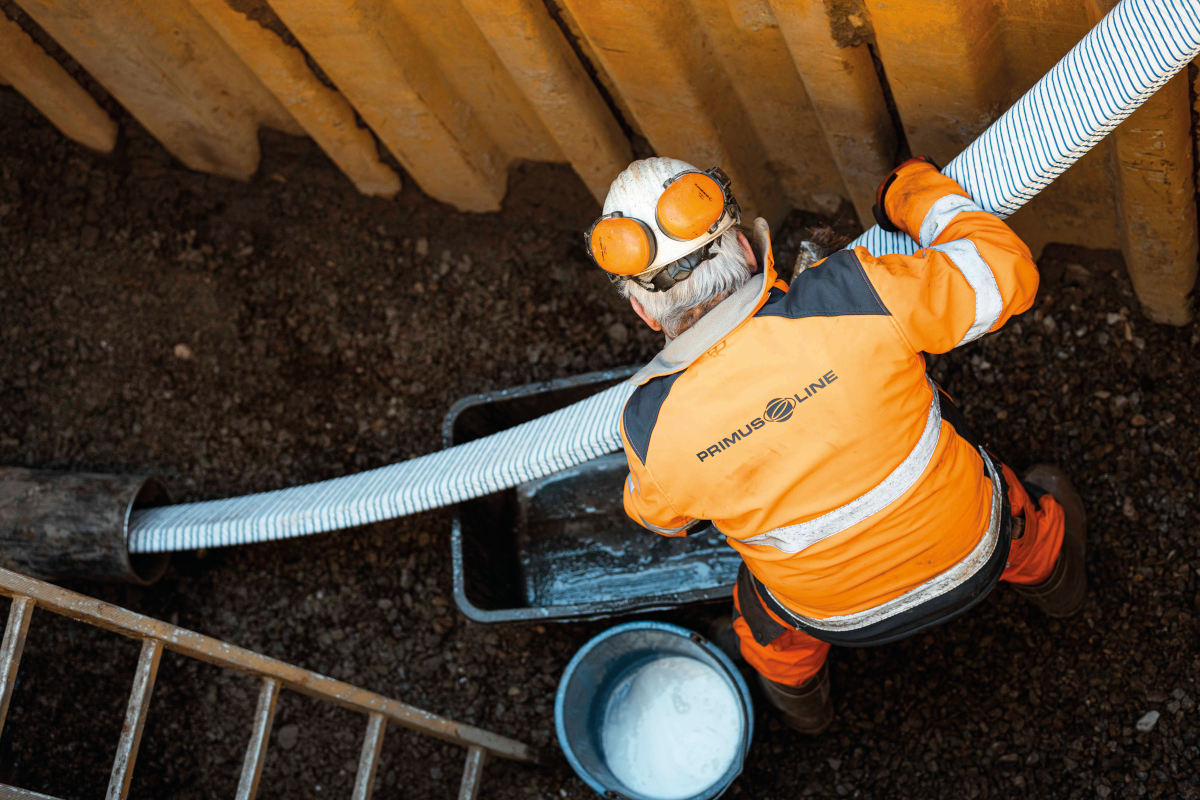Brisbane Water Relishes Proactive Role in Trenchless Technology
 In late October, hundreds of trenchless technology experts, usersand suppliers from around the world will converge on Brisbane, Australia, forthe International No-Dig Conference — widely regarded as the leading trenchlesstechnology conference in the world.
In late October, hundreds of trenchless technology experts, usersand suppliers from around the world will converge on Brisbane, Australia, forthe International No-Dig Conference — widely regarded as the leading trenchlesstechnology conference in the world.
How have trenchless technologies advanced in this part of theworld since Perth was the first city in Australia to host No-Dig? Indeed, howadvanced and relevant can trenchless technologies be in the world’s sixthlargest country (it is more than 31 times the size of the United Kingdom) thatlays claim to the world’s lowest population density with just more than 20million inhabitants?
Uncovering Brisbane
Brisbane is located in the southeast corner of Queensland — or aslocals call it the Sunshine State — on the Australian east coast. Brisbane isAustralia’s third largest city and it is home to approximately 1 million people,with around 1.7 million in the greater Brisbane metropolitan area. With sunny,mild winters and long summers, it comes as no surprise that Brisbane is regardedas Australia’s fastest-growing capital city, both in number of residents andcommercial operations.
This same climate has meant that Brisbane and the overallQueensland economy have traditionally been strongly reliant on the tourismindustry. The Gold Coast and Surfers Paradise are only a short drive fromBrisbane and international tourist meccas such as the Great Barrier Reef, Cairnsand the Daintree Forest, which are located in the north of the state. With theselandmarks, the tourist market continues to thrive and will remain an importantpart of the economic backbone and social culture of the state for theforeseeable future.
However, in recent years the economic structure of the region hasdiversified, particularly in the areas of technology and aviation. This can becontributed in part to the Queensland Government’s drive to change the image ofthe Sunshine State to a Smart State through the Smart State Strategy 2005-2015.Alarge part of this plan has been highlighting not only the lifestyle benefits ofBrisbane, but also the economic benefits for commercial operations and asignificant investment in biomedical research. Coupled with the aggressiveinvestment attraction efforts of Brisbane City Council, this campaign has seensuch major companies as Virgin Blue and Boeing Australia establish theirnational headquarters in Brisbane.
Growth in residential development is following suit. As in therest of the world, inner city brownfield sites are being rapidly demolished andcleared to make way for upmarket inner city apartments. An excellent example ofthis in Brisbane is the proposed new development of the former port site atHamilton. Located just outside the CBD with prime riverfront access, over thenext 20 years this site, formerly home to containers, timber exports and motorvehicle imports, will house up to 10,000 residents in state-of-the-artapartments and will attract thousands of visitors each week to shop and dine inthe precinct.
According to the 2005 Queensland Government Submission on theEconomic Impacts of Migration and Population Growth, Queensland has recordedstronger population and economic growth on average than the rest of Australiaover the 15 years to 2003-04. As the fastest-growing region in the nation, SouthEast Queensland has many challenges to face, not least of which will besustainable infrastructure development, including the region’s water supply.
The Water Supply & Infrastructure
Brisbane Water, a commercialized business unit of Brisbane CityCouncil, supplies water services in the region to residents and businesses.Employing approximately 900 staff, Brisbane Water is responsible for everythingfrom the treatment and distribution of the water supply, to the treatment anddisposal of the city’s wastewater.
Brisbane Water manages a wide range of natural and built assetswith an estimated value of more than $5.4 billion (AUD). This includes 49reservoirs, three water treatment plants, 93 water pumping stations, 11wastewater treatment plants and 199 wastewater pumping stations. Each day,Brisbane Water delivers more than 960 million liters of drinking water to morethan 1 million customers.
As the largest local government body in Australia in terms ofpopulation and budget, Brisbane City Council has a big task on its hands to meetthe needs of the 1.7 million residents who rely on it for a clean and reliablewater supply and wastewater services.
Big is no exaggeration. More than 13,000 km of water supply pipesand wastewater pipes are maintained and operated by Brisbane Water. That’senough to stretch from Brisbane to the North Pole. Close to 400,000 residentialproperties and 34,000 industrial and commercial customers are serviced by thisinfrastructure.
While not as old as many of the water infrastructure systems inEurope and North America, some of the older suburbs of Brisbane are serviced bypipes that have seen the better part of a century of service. The first waterpipes in Brisbane were laid in 1870, and the first wastewater pipes were laid inMarch 1914. Over the years, pipes have been constructed of cast iron, steel,concrete and plastic, depending on their age, size and location.
What does this all mean when it comes to water supply and thecity’s water infrastructure? Without a doubt, one of the greatest challenges forthe city’s planners is the supply of water and wastewater services to newresidential developments.
Planning to meet these future needs is imperative, and the methodsby which they are going to be met are high on the agenda. But even higher on theagenda at the
present time is the current water situation in Brisbane. TheBrisbane region is currently experiencing the worst drought in 100 years and thecity is under water restrictions. State and local governments are assessing theviability of a range of alternative water supply options, includingdesalinization plants, the construction of new dams and residential applicationsof recycled water.
Asset Management
Maintenance of this existing infrastructure is a key focus for thestaff at Brisbane Water. Operating under a broad range of licenses andregulations, they must report on performance to a range of environmental andsocial bodies including the Environmental Protection Agency, QueenslandCompetition Authority and the Department of Natural Resources and Mines, amongothers. So there is no room for complacency.
Faced with this challenge, asset maintenance has become anincreasingly vital role and one that Brisbane Water has wholeheartedly embraced.When other councils throughout Australia waited for regulations to be enforced,Brisbane Water has been proactive. In 1976, Brisbane Water voluntarily commenceda preventative maintenance program in place of a simple fault repair program.This program involves checking each pipe on a rotational basis every seven to 10years so faults can be corrected before major problems occur.
More recently, a dedicated asset management team at Brisbane Waterhas been busy introducing asset management technology since 2000. Utilizing anexisting program from Germany, the Brisbane Water staff has been adapting theprogram to make it compatible for use in the Australian environment. Oncecompleted, it will enable staff to analyze samples from the network and producereports to protect and maintain the city’s significant asset base.
The current prolonged drought has also made asset maintenance anincreasingly high-profile item on the political agenda, particularly with regardto the prevention and management of leaks. When residents are under strict waterrestrictions, it is vital that high-profile water main leakages resulting insignificant water loss are prevented. Maintenance programs and new engineeringtechnology, particularly in trenchless methods, are key elements in thisstrategy.
Trenchless Technology in Brisbane
Trenchless technology is not a new concept at Brisbane Water. Infact, many will be surprised to learn that the first-ever Australasian Societyfor Trenchless Technology (ASTT) conference was hosted in Brisbane. Manydifferent types of trenchless technologies are regularly employed on projects,including relining, directional drilling, microtunneling and guided boring.Since 1968, more than 60 km of pipe has been rehabilitated and hundreds ofkilometers have been replaced — all using trenchless technology methods.
In fact, Andris (Andy) Krumins, manager of strategic planning,policy and innovation at Brisbane Water and conference chairman of No-DigDownUnder, vividly remembers the first trenchless project undertaken in Brisbaneback in 1968, when a 15-in. diameter sub main measuring two miles long wassliplined in the city’s Chermside Branch Sewer.
“Tannery waste had caused the concrete pipes to near collapse fromcorrosion. The sewer was up to 40 ft deep and in a built-up area — a problemindeed. We had a company make PVC pipes for us, as they were not in the generalmarket at that stage, and we devised a methodology to insert and grout them.Great work for 1968 and the pipes are still in full service today,” Kruminssays.
Working with trenchless technology for the past 40 years hasdriven Krumins to the forefront of technological developments in the field andnot only in Brisbane.
In the 1980s, he oversaw the installation of a PE slipline atNorman Creek in the city’s east. At nearly three miles long, it consisted of a36-in. diameter sewer up to 98 ft deep. Undertaken with project partners ACINylex and Vink & Hoeglund, it was the largest project of its type in theSouthern Hemisphere at the time.
This was followed by a four-mile Insituform project of a 36-in.diameter sewer line through the CBD. The project partner in this case wasMonier, and the end result was the deepest Insituform reline in the world at 35m.
And the world firsts didn’t end there, with the first reline usingspiral wound PVC undertaken in the 1980s. This pipe was three miles in lengthwith a 33-in. diameter. The project was the first time that locally-developedDanby spiral wind technology had been used. This technology is now in operationthroughout the world.
A major project undertaken more recently was relining of six milesof 20- and 50-year-old, 51-in. diameter steel and pre-stressed concrete pressuremains. This was a $12 million (AUD) project and the first lined pressure mainproject in Australia to prevent concrete corrosion.
These projects are just the tip of the iceberg. These days, allpipe work projects are assessed for their viability to use trenchlesstechnology, and it is utilized wherever appropriate. However, there is certainlyopportunity for the technology to be more broadly used in the Australian market.
Trenchless Challenges
According to Krumins, one of the major restricting factors to thebroader use of trenchless methods in Australia is the lack of experience withthe technology by consulting engineers. He has been lobbying universities inQueensland to introduce more specific trenchless technology methodology toengineering curriculums. This will go a long way to increasing its use anddevelopment in the long term.
It is also vital that Australia produces and retains an increasingnumber of qualified engineers. Unprecedented economic growth in Queensland hasled to a skills shortage of engineers, consultants and a general engineeringworkforce.
Krumins also believes that one of the main challenges faced by thetrenchless technology industry in Australia is the lack of climate specificdesigns.
“In Brisbane there is a great need for climatically suitabletrenchless technology and designs. Often we are using European designs, whichare simply not suitable for our sub-tropical climate. [Hydrogen sulfide]corrosion is an acute problem because of this,” Krumins says.
As a result, Australian companies have been pushed to theforefront of the industry in terms of innovation and development, as it hasforced them to develop their own more suitable technologies.
Partnerships with international firms need to be high on theagenda when developing and adapting existing technologies. “Australian watersuppliers need to be shown what technology is available and then how it can beaccessed in Australia.
We need to look at the traditional supply approachand possibilities for international partnerships so we can have project deliveryavailable on the ground,” Krumins says.
“We also need to look at the penetration of trenchless technologycompanies in Australia,” he continues. “Many set up their South East Asiaheadquarters in Bangkok, Singapore and elsewhere in Asia. We need to look atattracting some of these companies to Australia.”
Attracting them should not be an issue, if future projects areanything to go by. Although Australia has a small population base, there aresignificant projects already under way and in the early development stages thatare prime candidates for trenchless methods. These include the $3-plus billion(AUD) Brisbane cross-river transport link, $600 million (AUD) southern pipelinescheme and $800 million (AUD) western corridor pipeline scheme.
In a country with strict social and environmental policies andstandards for developments, trenchless technology will undoubtedly be at theforefront of all pipe related infrastructure developments.
No-Dig DownUnder 2006
It is evident that trenchless technologies are already beingwidely applied in the Brisbane and Australian markets and that local users suchas Krumins are constantly looking at ways to implement and adapt the technologyto the local environment. Hosting No-Dig DownUnder 2006 will certainly provide aunique opportunity for increasing this profile.
Krumins will also be taking the opportunity to profile some of thelatest technology developed by Brisbane Water, including new fully welded PEsewer systems with welded maintenance shafts. The lack of joints in the pipeseliminates one of the major pipe defects seen in Australia — tree root blockage.This in turn removes the need for manholes and embraces trenchless technology.
As conference chairman, Krumins has played an instrumental role indeveloping the conference program. “The program has now been finalized and wehave one of the best line-ups of local and international speakers ever seen at aNo-Dig conference,” he says. is great opportunity for people in the industry tolearn about advancements in the industry, and see new technology first hand, andall in the one location.”
Kathryn Tyrrell is communications consultant — with the marketingand communications branch for Brisbane Water.




